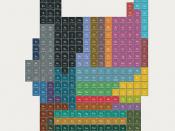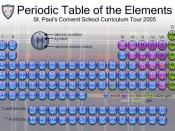Properties of the elements of period 3 (Na - Ar) to illustrate the periodic trends
What is periodicity?
Periodicity is the repeating pattern in which the elements are arranged in the periodic table, these are some of the trends shown from looking at the periodicity of the elements.
Atomic radius
An atom doesn't have a fixed radius. The radius of an atom can only be found by measuring the distance between the nuclei of two touching atoms, and then halving that distance. Atomic radius is measured in nm.
The graph shows that atomic radius decreases across a period (from left to right). This is because the number of protons in the nucleus increases so the nuclear charge increases. The force of attraction between the nucleus and the electrons increases so the electrons are drawn more tightly to the nucleus so the size of the atom (and the atomic nucleus) decreases.
The atomic radius of Argon cannot be measured because it is a noble gas so doesn't form bonds.
First Ionisation energy
The first ionisation energy is the energy required to remove the most loosely held electron from one mole of gaseous atoms to produce 1 mole of gaseous singly charged positive ions. Ionisation energy is measured in Kjmol.
M(g) ----------- M+(g) + e-
First ionisation energy increases across a period because going across the period the number of protons in the nucleus increases so the nuclear charge in each element increases therefore the force of attraction between the nucleus and outer electron is increased, and there is a negligible increase in shielding because each successive electron enters the same energy level so more energy is needed to remove the outer electron.
Some anomalies occur in this graph and other graphs of first ionisation energy. The Anomaly in this graph...


